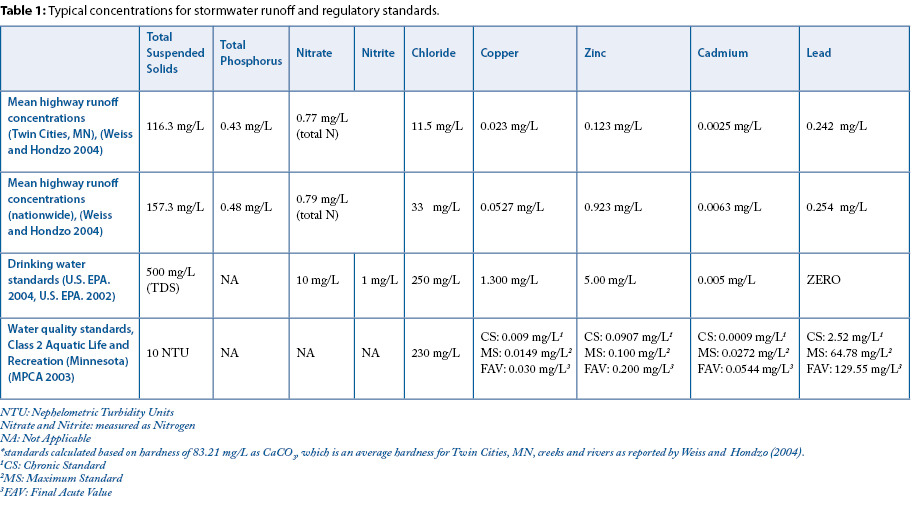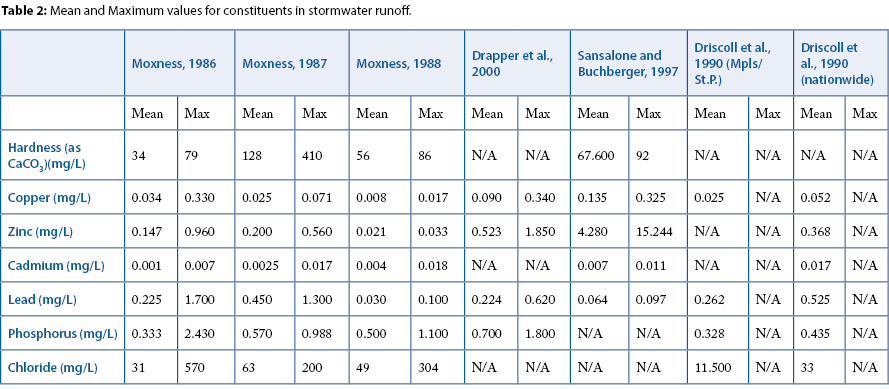
Nomenclature
A.J. Erickson, J.S. Gulliver, P.T. Weiss, R.M. Hozalski
Variability in nomenclature concerning stormwater and stormwater treatment can be confusing and misleading. The stormwater-related terms used throughout this manual are defined below.
Assessment: Assessment, with regard to stormwater treatment practices, is the process for determining whether a stormwater treatment practice is effective at meeting one or all of its design objectives. Assessment may include visual inspection, testing, or monitoring.
Biologically Enhanced Practices: Biologically enhanced practices are stormwater treatment practices that utilize biological processes in addition to filtration, infiltration, or sedimentation to enhance quantity control or pollutant retention performance. Examples include constructed wetlands, rain gardens (bioretention), filter strips, and swales.
Capacity Testing: Capacity testing is the second level of assessment and relies on a set of point measurements to estimate the stormwater treatment practice’s hydraulic conductivity or sediment retention capacity.
Discharge: Discharge is the rate at which fluid (typically water) is transported in units of volume per time (e.g., cubic feet per second, cubic meters per second, gallons/day, etc.)
Effectiveness: Effectiveness, for stormwater treatment practices, is a measure of the ability of a stormwater treatment practice to meet an objective (e.g., reduce peak runoff volume or rate, reduce total runoff volume, increase groundwater recharge, or retain one or more target pollutants), typically expressed as a percentage. For example, the effectiveness at reducing runoff volume of a bioretention facility that reduced runoff volume from 1000 cubic feet to 460 cubic feet through infiltration, evapotranspiration, and other processes is 54%.
Evapotranspiration: Evapotranspiration is the combined result of evaporation and transpiration. Evaporation is the process by which surface water or soil moisture is converted to water vapor and released to the atmosphere. Transpiration is the process by which vegetation releases water vapor to the atmosphere.
Filtration: Filtration, for stormwater treatment, is the process by which a pollutant is removed from stormwater runoff by passing through filter media (sand, soil, or other) which captures the pollutant but allows the stormwater to pass through. Stormwater filters use a collection system (e.g., perfo-rated pipe) to capture treated stormwater and transport it to a stormwater delivery system or receiving waters.
Flow: Flow is the process by which liquid water is transported from one location to another. For stormwater, there are three principal methods in which flow can be transported: open channel flow, pressurized conduit flow, and subsurface groundwater flow.
Infiltration: Infiltration is the process by which surface water seeps into the soil and percolates to the groundwater system. Depending on the depth of infiltration, groundwater flow patterns, and topography, infiltrated water can re-emerge as surface water at a different location and a later time.
Maintenance: Maintenance for stormwater treatment practices is performing actions that sustain or improve the function or treatment capability of the practice. Maintenance includes, but is not limited to, removing sediment or vegetation, repairing infrastructure, enforcing regulations (e.g., for lawn fertilizer or pet waste disposal), among others.
Monitoring: Monitoring is the fourth level of assessment and relies on sampling during natural storm events using permanent (or semi-permanent) data collection equipment (e.g., flow meters, samplers, rain gauges). Monitoring is typically a long-term process involving data collection over several storm events and spanning 14 or more months.
Open channel flow: Open channel flow is the process by which water is transported by gravity with a free surface exposed to atmospheric pressure. The channel that forms the means of conveyance can be natural (e.g., streams, rivers) or constructed (e.g., culverts, canals, swales). Flow in closed conduits that does not fill the conduit is also open channel flow.
Pressurized conduit flow: Conduit flow is the transport of water in closed conduits (e.g., pipes) that are flowing full. Flow occurs because there is a longitudinal pressure difference along the conduit.
Sedimentation: Sedimentation is the process by which solids settle out of a water column, generally described by Stokes' Law.
Synthetic runoff testing: Synthetic runoff testing is the third level of assessment. It uses synthetic stormwater applied under controlled conditions with or without a well-characterized amount of pollutant to determine the effectiveness of stormwater treatment practices.
Source reduction: Source reduction is the process by which stormwater runoff volume is reduced, stormwater runoff quality is improved, or both, before the stormwater enters a treatment device or the storm sewer system. For example, street sweeping is source reduction because it removes sediment and other particulate pollutants before stormwater runoff carries them into the storm sewer system.
Stormwater best management practice (BMP): The U.S. EPA defines a best management practice (BMP) as “Schedules of activities, prohibitions of practices, maintenance procedures, and other management practices to prevent or reduce the discharge of pollutants to waters of the United States. BMPs also include treatment requirements, operating procedures, and practice to control plant site runoff, spillage or leaks, sludge or waste disposal, or drainage from raw material storage” (U.S. EPA. 2004a). For this manual, stormwater BMPs will be referred to as stormwater treatment practices.
Stormwater treatment practice: A stormwater treatment practice is a means for improving stormwater runoff quality, reducing runoff volume, reducing runoff peak flow, or any combination thereof. Examples of stormwater treatment practices are source reduction, sand filters, infiltration basins and trenches, rain gardens (bioretention), dry ponds, wet ponds, constructed wetlands, filter strips, swales, wet vaults, and underground sedimentation practices.
Stormwater runoff: Stormwater runoff is the water that flows over the ground surface or into conduits as a result of rain storms, snowmelt, or both. Water from rainfall events that infiltrates into soil, evaporates, or transpires directly from the surfaces of vegetation is no longer stormwater runoff.
Treatment process: A treatment process is the mechanism by which a stormwater treatment practice improves the quality of stormwater runoff. For example, a dry pond holds stormwater and releases it slowly (relative to uncontrolled conditions) to downstream receiving waters. The primary treatment process of a dry pond is sedimentation because most of the pollutants in stormwater that are retained by a dry pond are settled out while the stormwater runoff is held in the pond.
Visual inspection: Visual inspection is the first level of assessment and is a rapid assessment procedure that visually evaluates and photographically documents the effectiveness of a stormwater treatment practice. The primary purpose of visual inspection is to identify, diagnose, and schedule maintenance for stressed stormwater treatment practices.
Water budget: A water budget, for a stormwater treatment practice, is the accounting of water that enters, exits, and is stored by the stormwater treatment practice. The water budget assigns discharge values to each of the processes that affect the fate of water, including input processes (e.g., direct precipitation into the treatment practice, surface runoff, and conduit or open channel flow) and output processes (e.g., infiltration, evapotranspiration, and conduit or open channel flow). The goal for developing a water budget is to balance the inflows and outflows with minimal error.
Water quality: Water quality refers to the physical, chemical, and biological properties of the water. Stormwater quality is typically determined by measuring stormwater properties (e.g., temperature, phosphorus concentration) and then comparing the results to water quality standards (see tables 1 and 2). One goal of many stormwater treatment practices is to improve the quality of stormwater runoff by reducing the concentration or load of pollutants in stormwater runoff before delivery to receiving waters.
Water quantity: Water quantity of stormwater runoff refers to a volume of water that is treated by, and the rate at which it is released from, a stormwater treatment practice. Water quantity control of stormwater runoff is the process by which a stormwater treatment practice stores runoff, reduces the peak flow, converts stormwater runoff to stormwater infiltration, evaporation, transpiration, etc, or any combination thereof.


References
- Drapper, D., R. Tomlinson and P. Williams. 2000. Pollutant concentrations in road runoff: southeast Queensland case study. Jour. Environ. Engineering 126(4):313-320.
- Driscoll, E., P.E. Shelley, and E.W. Strecker. 1990. Pollutant loadings and impacts from highway stormwater runoff, volumes I-IV. United States Department of Transportation, Federal Highway Administration, Report No. FHWA/RD-88-006-9.
- Minnesota Pollution Control Agency (MPCA). 2003. Minnesota Rule 7050.0222. Pages Specific standards of quality and purity for class 2 waters of the state; aquatic life and recreation. Minnesota Pollution Control Website: http://www.revisor.leg.state.mn.us/arule/7050/0222.html.
- Moxness. 1986. Characteristics of urban freeway runoff, phase I. Water Quality Unit, Environmental Services Section, Office of Technical Support, Minnesota Department of Transportation, St. Paul, MN, USA.
- Moxness. 1987. Characteristics of urban freeway runoff, phase II. Water Quality Unit, Environmental Services Section, Office of Technical Support, Minnesota Department of Transportation, St. Paul, MN, USA.
- Moxness. 1988. Characteristics of urban freeway runoff, phase III. Water Quality Unit, Environmental Services Section, Office of Technical Support, Minnesota Department of Transportation, St. Paul, MN, USA.
- Sansalone, J.J., and S.G. Buchberger. 1997. Partitioning and first flush of metals in urban roadway stormwater. Jour. Environ. Engrg. 123: 134.
- U.S. EPA. 2002. EPA Ground Water & Drinking Water - Secondary Drinking Water Regulations: Guidance for Nuisance Chemicals. http://www.epa.gov/safewater/consumer/2ndstandards.html.
- U.S. EPA. 2004. EPA Ground Water & Drinking Water. Current Drinking Water Standards. U.S. Environmental Protection Agency. Washington, D.C. http://www.epa.gov/safewater/mcl.html.
- Weiss, J., and M. Hondzo. 2004. Laboratory Measurements of Stormwater Quality Improvement in Detention Ponds. Project Report No. Mn/DOT 2004-21. St. Anthony Falls Laboratory, University of Minnesota, Minneapolis, MN.
Continue to Related Links.